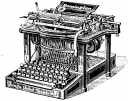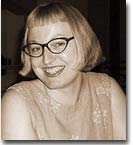

Forum is an on-going discussion site focussed on one particular question per issue proposed by revolving guest editor/s who will conceive of the question and invite specific respondees as well as selecting from reader responses. Other readers are invited to reply with their written views of the announced FORUM question; those views will be considered for publication in this section and may be e-mailed to the FORUM editor. FORUM remarks will, in most cases, be excerpted if included and will be chosen with an eye for introducing new points-of-view that have not yet been expressed. This issue's co-editors are Kathy Lou Schultz and Robin Tremblay-McGaw (see bios below). Guest editor for H2/n3 is Wendy Tronrud. (See her question at the end of this section.)
THE QUESTION
For this issue's Forum Kathy Lou Schultz and Robin Tremblay-McGaw address issues of class and poetics: "Thanks to the efforts of feminist poets, critics, and editors, it is now possible to identify a discourse -- both scholarly and creative -- of gender and poetics. In the 1980s, journals such as HOW(ever) put the spotlight on these issues, particularly as related to innovative or experimental practices and how these intersected with issues of publication, erasure, and canon formation.
A decade later, we find ourselves trying to define a vocabulary for addressing complex issues of class in the formation of an innovative poetics. As Kathy Lou Schultz asked in her Tripwire essay (N.1, Fall 1998 & appearing in this issue of HOW2), "What's a working class poetic, and where could I find one?" How do we make present the "absence" of class in discussions of gender and the poetics of innovation? Where are the intersections of race in discussions of class? How are these forces fused or CON-fused?
How do/can we picture/trace working class issues in formally innovative ways? What do the circumstances of literary production -- surrounding writers and the writing produced -- have to do with one another?"
Kathy Lou Schultz was born in Burke, South Dakota in 1966. In the past 20 years she has held numerous jobs including counselor for battered women, grassroots organizer, volunteer coordinator, Nebraska vacation guide, childcare worker, proofreader, and creative writing instructor. Currently she works as an editor in the high-tech industry in San Francisco. She is the author of Genealogy (a+bend press, 1999) and Re dress (San Francisco State University, 1994) and is a founding editor of Lipstick Eleven and Duck Press.

Robin
Tremblay-McGaw co-edits Lipstick Eleven [http://www.duckpress.org]
with Kathy Lou Schultz and Jim Brashear. Her work has appeared in 6ix,
Mirage, Potepoetzine, non, lyric&, TO
and elsewhere. Her 1996 chapbook, after a grand collage is available
from SPD. She has worked as a waitress, gas station attendant, fast food
worker, bookstore clerk, English composition instructor, and is currently
a librarian and web master at a nonprofit working to prevent gun violence.
|
FORUM Contributors |
The next FORUM question is posed by Wendy Tronrud: I would like to address what it may mean to locate oneself as both a reader and a writer of a graphically oriented and movable text (hypertext) within the parameters of cyberspace. The change in medium from book to cyberspace undoubtedly alters the physical experience of creating and finding meaning. The hypertext is an image linked within the greater structure of cyberspace. As readers, we not only read these images, but are capable of watching them perform.
In the essay "Virtual Topographies,"* Mark Nunes states that the hypertext is "not the writing of a place, but rather the writing with places, spatially realized topics." In the striated space of cyberspace, how may the hypertext rearticulate the textual landscape? If writing a hypertext also includes visually writing its architecture of place within the virtual medium of cyberspace, how may the act of writing and reading be rearticulated? Does this change in medium also effect our notion of stable spaces and is it perhaps envisioning a virtual city in which textual language acts as a structuring component? If so, how can we, as writers and readers, locate ourselves within this transphysical city of language?
*Cyberspace Textuality. Ed. Marie-Laure Ryan. Bloomington: Indiana University Press, 1999.
Reader responses invited for publication in HOW2/ "Forum 3" c/o:
Wendy Tronrud tronik@hotmail.com.
(this issue's table of contents)
